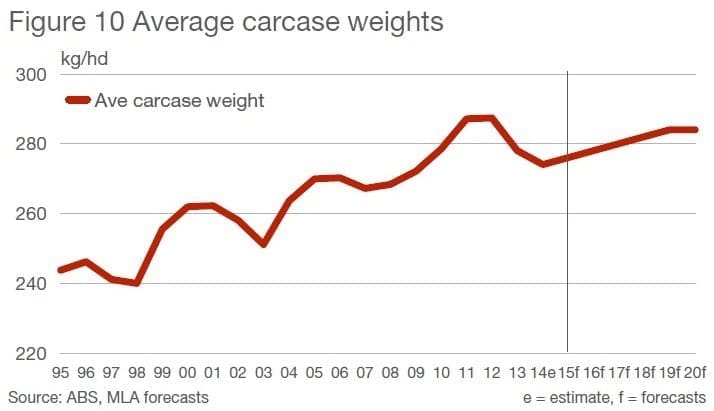WILL heavier carcase weights be part of the Australian beef industry’s response over the next few years, as it struggles to maintain production volume in the face of a savagely reduced cattle herd size?
It appears likely to be at least part of the answer, if recent trends in the US are anything to go by.
While there are obviously big differences between US and Australian beef production systems, recent events in the US industry nevertheless provide some insight to possible future trends here.
Drought and competing land use has already pushed the US beef herd size to a 60-year low. That’s led to placements in US feedlots during February 8pc below the same month last year, while fed cattle turnoff in February was the lowest for the month since USDA reporting began in 1996.
Faced with its rapidly declining herd size and annual calf output over the past seven years, the US industry continues to add weight to slaughter cattle, in a process which is at least partially offsetting the nation’s calf-getting deficit.
With fewer cattle on feed and lower corn prices, abundant feedlot capacity has allowed US cattle to stay on feed longer. This, combined with record high fed cattle and beef prices, has seen US cattle marketed at historically high weights over the past 12 months.
Recently, average steer carcase weights in the US went within a whisker of 400kg, and heifers, 371kg. To further illustrate this point, kills across a single week in the US recently were 23lb (10.5kg) higher than this time last year. That’s the equivalent of adding an additional 23,000 head to that week’s slaughter.
Similar trend occurring in Australia
In contrast to the carcase weight figure of close to 400kg in the US, carcase weights in Australia last year (both male and female cattle) averaged 278kg, or close to 120kg less.
In Brazil, the figure last year was 238kg, slightly more than a year earlier due to a reduced Brazilian female kill.
But just as slaughter weights have continued to push relentlessly higher in the US over the past decade, a similar trend is occurring here.
The MLA graph published here shows that Australian beef carcase weights in 1998 averaged just 240kg, rising 50kg over the next 13 years to close to a record 289kg in the ‘wet years’ of 2011-12.
Since then, drought has obviously taken the edge off weights, slipping a further 4kg last year, as more females entered the kill and a greater proportion of cattle ‘lacking finish’ were slaughtered.
Further back, average Australian carcase weights in the early 1980s were a little over 200kg, meaning Australian carcase weights have increased 1.8kg/year on average over the past 30-odd years.
The graph published above clearly shows that seasonal fortunes exert a very big bearing on slaughter weights. But equally, the long-term trend remains consistently higher.
While it is perhaps still too early to associate future advances in carcase weights with the recent sharp decline in Australia’s beef herd, its likely to be a contributing factor in coming years, a number of stakeholders are telling Beef Central.
MLA expects the Australian beef herd to decline to 26.8m head by June 30 this year – going from what was a 35-year high to what will be a two-decade low, in the space of just 24 months. It’s likely to fall considerably further by mid next year due to this year’s sustained high rates of kill due to drought, and smaller breeding herds with fewer calves coming through the system.
The flow-on effects from this are likely to last until at least 2020, impacting available supplies, while at the same time, testing market willingness to compete for limited quantities of Australian beef.
Given a return to more normal seasonal conditions and a somewhat higher proportion of the national kill being made up of steers, MLA expects to see carcase weights again start to increase in coming years.
“Barring drought, we can’t see any reason why the recent progression in carcase weight should not continue, if not increase,” MLA’s senior analyst Ben Thomas told Beef Central.
Having said that, he pointed to constraints in the Australian beef production system that made direct comparisons with what’s happened in the US difficult.
Only about 33pc of overall slaughter cattle enter grainfed programs in Australia, compared with almost all eligible cattle (steers and heifers) in the US industry. This leaves Australian carcase weights much more exposed to the impact of seasonal variations, among the majority of grass-finished cattle, Mr Thomas said.
Greater proportions of females killed during dry years only exacerbated that trend.
Nevertheless, MLA sees Australian carcase weights continuing to rise, over time.
“Given what they have done over the past decade or two, we’d see no reason for that to now level off,” Mr Thomas said. “It’s been volatile, but for average carcase weights to rise 1.8kg each year over a long period, that’s quite illustrative for future rises. I certainly don’t think we have hit a limit.”
“I’m certain there is still plenty of room for growth, seasons dictating. Heavier weights look likely, to offset the looming decline in slaughter numbers, but that partly comes back to how economically viable it is in Australia to grain-feed more cattle, for longer. The three factors in that are feeder steer purchase price, finished cattle exit price, and grain price.”
Contributors to long-term rise in weights
Having discussed the influences on rising carcase weights with a number of processors, lotfeeders and other industry stakeholders (click here to view this morning’s companion story), Beef Central has come up with the following list of contributors to the long-term rise in carcase weights:
Genetics: Improved, data-driven genetics across all breeds is providing heavier weights, at a younger age, without delivering excessive fatness in carcases,and better dressing percentages and carcase yield.
Expansion in lotfeeding: Growth in lotfeeding explains some of the expansion in national carcase weight. Both feedlot capacity and numbers on feed has doubled in the past 20 years, delivering a greater proportion of heavier grain-finished cattle.
Larger proportion of cattle destined for export markets. A record 74 percent of Australian beef production last year went into export markets, where heavier weights are more acceptable. The domestic market share has slipped from around one third (33pc) during much of the 2000s to just 26pc last year.
Heavier carcase weights in domestic market cattle: Within the domestic market category, both grass and grainfed trade steers and heifers have increased in weight over the years, lifting the ‘bottom-end’ of the overall carcase weight spectrum. That is particularly evident in categories like YG Grainfed, where prior to 2000, carcases over 260kg were ‘unwanted’. Today the top grid buy in the category is often out to 320kg.
Growth in live export: Live cattle export markets predominantly demand lighter cattle, potentially taking those animals ‘out of calculations’ in the mix of processing carcase weights. That applies particularly in a year like 2014 when live exports accounted for a record 1.1 million head.
Processor grid signals: Processor grids have increasingly ‘incentivised’ heavier carcase weights in many categories, ranging from steer to cow, as well as domestic heifers and steers mentioned above. At the same time, age/maturity measures have moved the other way.
Weight trend being seen in all species
Recent commentary out of the US suggests that all meat protein species – not just beef – have been recording long-term carcase weight increase trends.
“The trend for weights for all main species has continued upward for many years, with that growth being driven by changes in technology and, primarily, genetic capability for lean growth,” US analyst Len Steiner said in a recent edition of Daily Livestock Report.
“Cattle and pig feeders would have raised larger animals years ago except for the fact that they matured physiologically and began depositing too much fat. Relentless selection for animals that would put on less fat and more lean at heavier weights enables producers to economically take them to larger weights, spreading fixed costs of buildings and land and the ‘sunk’ costs of sows and cows over more pounds of output,” he said.
US packers also encouraged the increase, with larger and larger discounts on lighter-weight animals for the same reason: It takes no more buildings or labour to process a large animal than it does to process a small one, making large animals more profitable.
“About the only costs that get larger as cattle and pigs get larger are utilities (more electricity to chill big carcases) and packaging,” Mr Steiner said.
While lean growth had been less of a factor in the progression towards larger chickens, the same cost-spreading applies to birds. Selection for growth rate has driven US bird weights higher and the advent of boneless poultry products and the fact that those can be more efficiently taken from larger birds continued to push weights higher, he said.
Lamb and mutton carcase weights in Australia tell a similar story. Excluding the impact of drought years, both lamb and mutton carcase weights have risen consistently in Australia over the past decade or two. Lambs averaged 21.9kg last year (slightly impacted by drought), up 10pc from 20kg in 2005, and 22pc higher than the 18kg recorded back in 2005.
- Click here to view this morning’s second report on supply chain stakeholder views on advancing carcase weights.





HAVE YOUR SAY